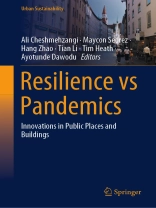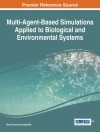“Resilience vs Pandemics: Innovations in Public Places and Buildings” explores innovative solutions for architecture and public places during and after the pandemic. Additionally, the authors contribute to the documentation of architectural and social transformations that have been prompted by previous transmissible diseases, as this knowledge can inform responses to future pandemics. In this volume, the chapters present critical, exploratory, multi- and interdisciplinary, and cutting-edge research approaches; with a particular focus on the effects of COVID-19 and other highly transmissible diseases on the design, use, performance, and perception of the built environment, particularly at the building scale. This volume aims to organize a collection of scientific studies, reviews, analysis, recommendations, and solutions in the fields of urban design, architecture, design, landscape design, etc.
The overarching goal is to document new approaches to createand enhance built environment resilience. Chapters shed light on novel methods, tools, processes, regulations, behaviours, and other relevant details contributing to a comprehensive understanding of this crucial issue. The two scales of the built environment under consideration are:
(1) Public Places, including research on transformations (death, emergencies, changes), requirements, adaptability, usability, virtual immersion, historical perspectives, interactivity, shifts in use and programs, etc.
(2) Buildings, including regulations, shifts in use and program, non-pharmaceutical interventions, human interactions, and human-machine interfaces.
The book covers a wide range of studies, including physical and non-physical studies, which may refer to the city infrastructure, green/blue spaces, housing, policy-making, health services, social and economic issues, etc. The findings and results of various global case study examples contribute to the decision-making of governments, organizations, and institutions, as well as inspire scholars and future research for developing resilience in the post-pandemic era.
Cuprins
Space and Resilience.- Innovations in Public Places.- Rethinking the Design of Vertical Green Spaces in the Post-Pandemic Era: Visitor Behaviour and Real-Life Cognitive Experience at Crossrail Place, London.- New Green Spaces for Urban Areas: A Resilient Opportunity for Climate Change Adaptation and Urban Health.- How Breaks in Nature can Affect the users’ Wellbeing: an Experience-based Survey During the Lockdown (COVID-19): Strategies for Healthy and Resilient Green Areas in our Cities.- Tactical Urbanism as an Innovative Urban Governance Tool: Lessons from the COVID-19 Pandemic.- Urban Parks and Mental Health Recovery During the Pandemic: Insights from an Iranian Case Study.- Innovations in Buildings.- How to Deal with Epidemic Disaster in Buildings – Introduction to the Epidemic Prevention Design Standard of Residential Building.- Impact of High-touch Surfaces on Potential Transmission of Diseases in Offices and Public Buildings.- The Resilience Principles of the Built Environment in Light of Climate Change and the Post-Pandemic Era.- Towards Resilient Public Places and Buildings to Pandemics.
Despre autor
Ali Cheshmehzangi is the world’s top 2% field leader, recognized by Stanford University. He is an urbanist and an urban designer with over 17 years of academic and practice experience. He leads initiatives in applied research and diligently works on co-creating synergies among academia, industry, and government. He is currently in a senior leadership and management role at Qingdao City University where he is a professor in Architecture and Urban Planning and the director/head of the Center for Innovation in Education and Research and leads international communications and certification for the university. He previously held several senior, leadership, and management roles as a full professor in Architecture and Urban Design, the head of the Department of Architecture and Built Environment, the founding director of the Urban Innovation Lab, the founding director of the International Network for Urban-Rural Research, the director of Center for Sustainable Energy Technologies, the founder and the head of Research Group for Sustainable Built Environment, and the interim director of Digital Design Lab. He was a visiting professor and now a research associate of the Network for Education and Research on Peace and Sustainability (NERPS), Hiroshima University, Japan. So far, Ali has published over 300 journal papers, articles, conference papers, book chapters, and reports. He also has another 18 academic books. Ali is an editor-in-chief of Springer’s Urban Sustainability Book Series and is globally known for his research in this prominent field. He has several award-wining books and has received several scholarly awards for his contribution and impact on higher education, applied research, and policy development.
Maycon Sedrez is a Brazilian architect and an urban designer, an artist, and an educator with a background in computational design and digital fabrication. His research areas include complexity and architecture, parametric design, digital fabrication, technologies, and urbanism. Maycon obtained his Ph.D. Diploma with excellence in Architecture, Technology and City from the University of Campinas in 2016. He contributed to the Institute for Sustainable Urbanism (TU Braunschweig—Germany) as a postdoc in the field of urban analytics. Later in 2019, he became part of the University of Nottingham Ningbo China’s team, leading the Digital Design Lab and acting as a course director and the deputy head of department. He is now a lecturer in Architecture at Deakin University in Australia (2023). He co-edited the book Contemporary Architecture and Automation published in 2018.
Hang Zhao is a researcher in the fields of urban planning, design, and management. She obtained Master of Urban Design at the University of Melbourne in 2021. Her professional skills cover city and regional planning, transportation design, landscape and architectural design, etc. Now, Hangis researching resilient cities and built environment at the University of Nottingham Ningbo China.
Tian LI is a researcher who studies resilience-oriented urban planning and management. She has a background in urban and rural planning, urban design, and regional analysis and planning. Tian completed her master’s degree with distinction, i.e., M.Arch. Sustainable Urban Design at the University of Nottingham, UK. Currently, she is researching at the University of Nottingham Ningbo China, and her research mainly focuses on pandemic-resilient urban strategies and urban public spaces.
Tim Heath is a qualified architect, a town planner, and an urban design practitioner having worked in the UK for over 30 years and for the past 15 years in China where he has undertaken consultancy and projects related to architecture, urban design and building, and urban environmental performance assessments. He is the course director of the M.Arch. Sustainable Urban Design and the director of postgraduate programs. He has previously been the director of the Institute of Architecture, the head of the School of the Built Environment, and subsequently the head of the Department of Architecture & Built Environment. He has also been the associate dean for Internationalisation and External Relations in the Faculty of Engineering and the acting vice provost for Research & Knowledge Exchange at the University of Nottingham Ningbo China (UNNC). He has also acted as an external examiner in many prestigious universities around the world for undergraduate and postgraduate programs as well as being a Ph.D. examiner. He has chaired many academic and professional accreditation and validation panels in the UK, Malaysia, China, and for the UAE’s Commission for Academic Accreditation. He is also a member of the Human Factors Research Group.
Ayotunde Dawodu is a sustainable urban researcher and an energy engineer with a zeal for developing and implementing sustainable solutions across the urban fields; waste management, transport, energy (efficient and renewable), spatial planning, ecology sectors; equipped with a B.Sc. in Mechanical Engineering, M.Sc. in Sustainable Energy Engineering, and Ph.D. Energy Technologies and Sustainable Development. He also possesses expertise in Sustainable Building Design/Analysis and strongly advocates integrated community participation in urban decision-making and planning. Ayotunde also specializes in sustainability assessment tool methods for evaluating guiding, ranking, and assessing the sustainability of buildings and communities. He is currently a senior lecturer in the Built Environment at the University of Greenwich, UK. He is also a certified BREEAM assessor, WELL accredited professional (AP), and a member of the WELL Concept “Communities’ Advisory group for International WELL Building Institute (IWBI), further attesting to his professional capabilities as a sustainability and health and wellbeing expert in the built environment.












